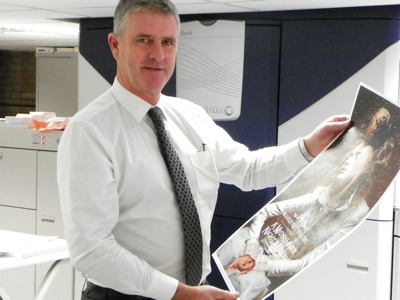Blissett Bookbinders is a binder to Her Majesty The Queen, and has been at the top of its field for decades. In today’s market though, growth is coming through digital print.
Gary Blissett has an appointment with The Queen later this year, but it is a different type of VIP – in this case a Very Important Press – that could really make a difference to his family company, Blissett Bookbinders. The installation of a Xerox iGen4 press in December 2012 has already started contributing significantly to the printing side of Blissett’s business, in particular because of its capability of printing on a 660 mm length sheet.
Managing director Gary, who is the third generation of the family to run the company (the fourth, Gary’s son Chris, is already running its photobooks service) describes the decision to invest in the Xerox as ‘probably one of the hardest decisions of my life’, as he weighed up the pros and cons of the iGen4 and an HP Indigo press. ‘Our Konica Minolta presses had come to the end of their lives and we had to invest in new and better technology. The two options were the Indigo, which we considered very seriously, or the iGen4. Indigo had done a massive marketing campaign, but when we saw the quality of the iGen4, it was equal in every respect. Not only that, it printed a 660 length sheet to very good quality. It became a no-brainer when we knew we could do larger covers and books with the iGen.
For commercial print, it gave us the option to print things we could not do with an ordinary SRA3 machine’. ‘I hadn’t been massively impressed with the iGen3, there was better quality in the market place, particularly the Indigo, and we had been very pleased with the Konicas to be fair. But the iGen4 stepped it right up. We have even captured some Indigo customers when they have seen the iGen4 quality.’ One highly effective feature on the Xerox press has been ‘acoustic transfer’. This uses ultrasound to help fuse the toner to the substrate. It enables digital printing onto a wider range of textured paper stocks, such as fine art papers. ‘The Indigo can do that, but most digital presses can’t,’ Mr Blissett continued. ‘The iGen4 does a very nice job of it. It will handle a lot of the papers that the Indigo does; metallic is pretty much the only type it won’t do. ‘We do have some fine art customers that want to give their customers something different.
It was another thing that sold the iGen. On top of the quality, it was the longer sheet size and the flexibility that gives us in book binding that swung the balance. We can produce book jackets, sleeves, and larger sized covers for 300 mm square photobooks, which SRA3 cannot do. In the commercial world, it allows A4 landscape brochures to be produced and A4 6-page brochures to be printed, so we’re able to take on the litho boys on that kind of work, and also short to medium run work and jobs that can be personalised with variable data.’ The investment decision was a big one in every sense: Blissett had to make a hole in the roof to get the press into its building in Acton, west London, from where the company has been operating since 1962.
It also required a complete reorganisation of the firm’s book binding and printing departments. Currently, around 60% of the company’s business remains binding work, with digital print now accounting for 40%. Mr Blissett expects digital print to continue to grow its share. He said: ‘It’s early days because we are only two months into running and marketing the Xerox press, but the signs are good. The 660 mm length sheet reduces print costs for runs of A4 books, because you can print 3-up instead of 2-up. It’s reducing our costs in the photobook market because of the size of the covers we can now print. It’s a much speedier machine, so we’re getting jobs through production much more quickly. It’s just allowing us to market new ideas to people that we have not been able to do before.’ For the future, Blissett is planning to rebrand and add new services, including a bespoke online ‘retail’ service, printing and binding items such as notebooks and diaries.
The company, which was established by Gary Blissett’s grandparents in 1920, has for many years enjoyed a thriving market in binding library books, but this is an area that is in decline, making the development of its digital printing arm even more critical. Blissett Bookbinders holds a royal warrant as a high quality bookbinder with traditional artisan skills, which it is increasingly combining with new digital technology. Speaking of royalty, there is that appointment with The Queen to come: Blissett has been invited to take part in the Coronation Festival in July – one of 180 companies that will show off their prowess in the gardens of Buckingham Palace before Her Majesty and an expected 60,000 visitors. The iGen4 will not be there, but digital remains the future for Blissett.





